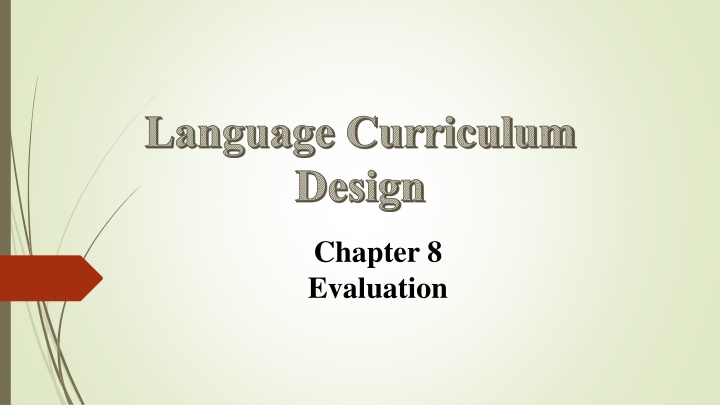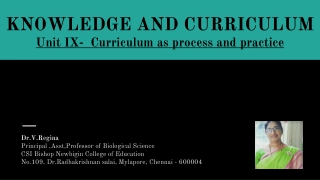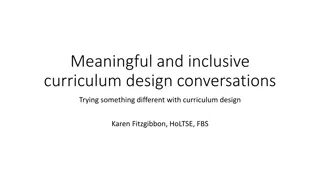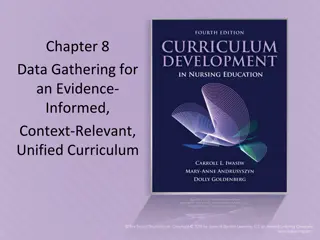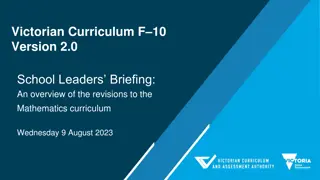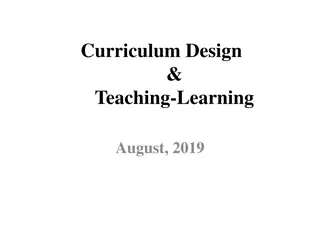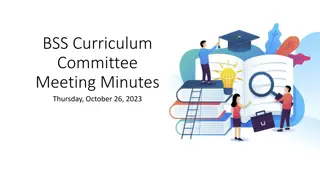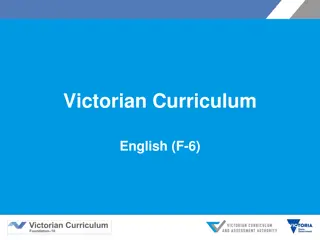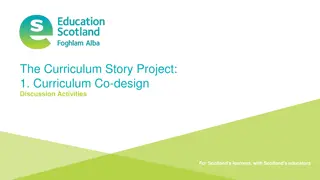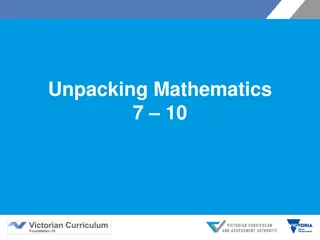Language Curriculum Design
This chapter delves into the importance of evaluation in assessing the success of a language course and identifying areas for improvement. It explores the process of evaluating various aspects such as teaching standards, learner preparation, satisfaction, cost-effectiveness, and more. The content discusses the steps involved in evaluation, the purpose, audience, type, and focus of evaluations in language curriculum design.
Uploaded on Mar 08, 2025 | 1 Views
Download Presentation

Please find below an Image/Link to download the presentation.
The content on the website is provided AS IS for your information and personal use only. It may not be sold, licensed, or shared on other websites without obtaining consent from the author.If you encounter any issues during the download, it is possible that the publisher has removed the file from their server.
You are allowed to download the files provided on this website for personal or commercial use, subject to the condition that they are used lawfully. All files are the property of their respective owners.
The content on the website is provided AS IS for your information and personal use only. It may not be sold, licensed, or shared on other websites without obtaining consent from the author.
E N D
Presentation Transcript
Language Curriculum Design Chapter 8 Evaluation
EVALUATION The aim is to decide how to check if the course is successful and where it needs to be improved.
What is an Evaluation? To see if the course is the best possible Looks for both at the results of the course, and the planning and running of the course. Is the teaching on high standard? Is the course preparing the learners properly for their use of English at the end of the course (e.g. to pass the TOEFL test, to study in an English-medium university, to work as a tour guide)? Are the learners satisfied with the course? Is the course cost effective?
Steps in Evaluation? 1 who the evaluation is for and what kind of information they need. 2 Find what the results of the evaluation will be used for . 3 Decide if the evaluation is necessary or if the needed information is already available. 4 Find how much time and money are available to do the evaluation. 5 Decide what kinds of information will be gathered. 6 Try to gain the support of the people involved in the evaluation. 7 Decide how to gather the information and who will be involved in the gathering of information. 8 Decide how to present the findings. 9 Decide if a follow-up evaluation is planned to check the implementation of the findings.
Purpose and Audience of the Evaluation three-way scope distinction (Kiely and Rea-Dickens :2006: 225 271 (1) large-scale evaluations (2) teacher-led evaluations, and (3) management- led evaluations who the evaluation is for and what kind of information they value. it helps determine the degree of confidentiality of the evaluation. it helps determine what kind of information should be gathered and what kind of information should not be gathered. The commission and relevant person( learners, directors, teachers) play important roles Brief mock report is needed the data will be provided willingly or reluctantly Is it being done to improve the course or to guide a decision whether to maintain or get rid of the course?
The Type and Focus of the Evaluation Formative Summative Purpose Improve the course Judge the course Purpose More likely to look at causes, processes, individuals More likely to look at results, standards, groups Type of data Used for counseling, mentoring, professional development, setting goals, adapting material Used to make decisions on adequacy Use of data Presented in a report Presented to and discussed with individuals Presentation of findings
The Type and Focus of the Evaluation Short term evaluation - quality of teaching/ teachers and learner achievement cannot be done in short term -One or two isolated observations may not show planning of a program and its conclusion. - Long term Evaluation - Most economic if it is planned - illuminative evaluation requires teachers to be active programme evaluators. process Engagement to the courses the quality of the interaction the quantity and quality of the language used. Product -result of the program what and how much was learnt Cognitive factors Learning&teaching Gaining the knowledge Application Resource factors Affective factors feelings of satisfaction and attitudes
Gaining Support for the Evaluation - A course evaluation looks for strengths and weaknesses - the sources of information should be trusted - there should be a cooperation with the source of information and evaluator - A proper evaluation can be an empowering and motivating activity. Gathering the Information -Interviews - Self-report scale (pros) large number of people and information clear focus on evaluation compare with the previous evaluation they tend to result in average results Self-report scales involve pre-determined questions and types of answers are often used for student evaluation of teaching
Observation analysing the course book, observing learning in lessons, observing teaching, analysing the coverage of curriculum design procedures, observing the performance of learners after the course. Structured observations (checklist) Like tests or dependent measures in an experiment items on it should be be clearly understood by each person using it Not too many, not too few items Should be based on a well-thought- out research system likely to be practical if it is not too long Unstructured observation Observer tries to see what is there without too many preconceptions. A small amount of time spent on there is a systematic coverage of what is important allow comparison between different courses, lessons, teachers pick up features that may not have been included in any checklist. A way of formative evaluation
Formative Evaluation as a Part of a Course 1 Parts of the curriculum design can be negotiated between the teacher and the learners (see Clarke (1991) 2 The course can include periodic and systematic observation of classes by teacher peers. 3 The staff hold regular meetings to discuss the progress of the course. 4 Teachers are required to periodically fill self-evaluation forms that they discuss with a colleague. 5 Learners periodically fill course evaluation forms. 6 Some class time is set aside for learner discussion of the course and providing feedback for teachers. 7 Occasionally an outside evaluator is invited to evaluate aspects of the course.
The Results of an Evaluation the results need to be presented in a confidential way The results of an evaluation may also be threatening to the individuals concerned The results of evaluations of teaching are usually only available to the teacher concerned particular comments by students may be reported A report of an evaluation needs to indicate the quality of the course and it must be made clear what the standard for the measure of quality is
Summary of the Steps 1 Discover the purpose and type of the evaluation. 2 Assess the time and money needed. 3 Decide what kinds of information to gather. 4 Gain the support of the people involved. 5 Gather the information. 6 Present the findings. 7 Apply what has been learned from the evaluation. 8 Do a follow-up evaluation.
